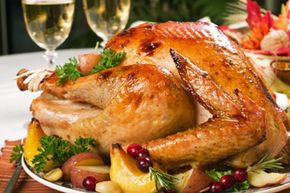Cooking a turkey for the holidays is one of the biggest meal preparation projects most people tackle all year. Just the size of the bird itself can be intimidating, not to mention all of the horror stories associated with the ghosts of ruined turkeys past. Believe it or not, cooking turkey is easier than it used to be, and whatever your method of choice, you can prepare a bird that tastes and looks great every time.
Avoid Rookie Mistakes
Almost everyone falls prey to at least one turkey gotcha at some time or another. If you're a novice at preparing this traditional American dish, avoid these mistakes:
Advertisement
- Allow for Enough Thawing Time - Turkeys are big and take a long time to defrost. The U. S. Department of Agriculture (USDA) recommends thawing the bird either in the refrigerator (one day for every 4 to 5 pounds or 1.8 to 2.3 kilograms), immersed in cold water (30 minutes per pound), or in the microwave according to the manufacturer's instructions. Never leave a turkey out to thaw at room temperature [source: USDA].
- Remove the Innards - Whole turkeys come with either one or two packets, which include the neck and giblets. They'll be concealed in the cavities front and back. Be sure to take them out when you prep the bird.
- Don't Stuff the Bird - Stuffing the turkey is a time honored tradition, but it also makes it harder to cook a succulent bird when you have to cook it long enough to heat the stuffing, too.
Add Extra Flavor
Turkey is a mild flavored meat that lends itself well to extra seasonings. You can do this a number of ways. When you add flavor with moisture, you help to increase the chances that the breast meat will stay nice and juicy through the cooking process. You can add juices by injecting the turkey with a mixture of ingredients, like butter, water and honey. There are special injecting needles available that make this an easy proposition. You can also add juices and flavor by soaking the turkey in a brine solution. This is an immersion bath of salt water and sugar to which you add spices. If these options seem like too much work, you can always just slather some herbed butter under the skin around the breasts and anywhere else you can reach.
Beyond moist flavorings, you can add any number of seasonings and rubs to the outer skin, or stuff the bird with aromatics, like sliced onions, celery, apples, sage, carrots, rosemary or anything else that strikes your fancy.
Review the Recipe
The good news is that you won't have to cook the turkey as long as your mother did. In 2006, the USDA changed the rules for how long you need to cook fowl in order to kill harmful bacteria. According to current guidelines, turkey should attain an internal temperature of 165 degrees Fahrenheit (74 degrees Celsius). This is lower than lots of recipes you'll find on the web and in print. You also have more cooking options than ever before. Beyond simply roasting the turkey, you can smoke it, deep fry or grill it. Any of these methods will yield a moist bird if you take the time to deal with one of the biggest challenges involved in preparing a whole turkey, uneven cooking [source: USDA].
Don't Overcook the Breast
Turkey breast cooks faster than the leg or thigh. The biggest trick in preparing turkey is to keep the breast from overcooking while the thigh and other dark meat comes up to temperature. Adding moisture to the raw turkey, as with injecting and brining, helps, but you'll also have to employ a cooking strategy that protects the breast from drying out. The one exception to this is when you can effectively seal the bird so moisture can't escape, as with deep-frying.
The most common method, and the one you're probably familiar with, is to tent the breast with aluminum foil. This isn't the only way, though. Raising the temperature when the bird first goes in the oven can help partially seal in the juices too. You'll find this method in some recipes that require an initially high temperature of 450 degrees Fahrenheit (232 degrees Celsius) or more with a bump down to the USDA minimum recommended cooking temperature of 325 degrees Fahrenheit (163 degrees Celsius) after a half hour to an hour. Another option is to start the bird with the breast side down and then flip it after an hour [source: USDA].
Other Tips and Tricks
To make monitoring the temperature of the bird as effortless as possible, place an oven thermometer in the thickest part of the raw thigh, away from the bone, before you stick it in the oven. This is the spot where you need to determine doneness. Take the bird out of the oven about three to five degrees shy of the desired temperature. It will keep cooking as it rests. Leave your masterpiece undisturbed for 20 to 25 minutes to redistribute the juices before carving.
That's it. With some spices, a reliable thermometer and a plan for keeping the breast meat from overcooking, you can prepare a perfect turkey every time. Just remember to make it look hard. That way you can get someone else to do the cleanup.
Advertisement
